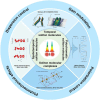Temporal and spatiotemporal soliton molecules in ultrafast fibre lasers
- PMID: 40182798
- PMCID: PMC11964144
- DOI: 10.1515/nanoph-2024-0590
Temporal and spatiotemporal soliton molecules in ultrafast fibre lasers
Abstract
Ultrafast fibre lasers, characterized by ultrashort pulse duration and broad spectral bandwidth, have drawn significant attention due to their vast potential across a wide range of applications, from fundamental scientific to industrial processing and beyond. As dissipative nonlinear systems, ultrafast fibre lasers not only generate single solitons, but also exhibit various forms of spatiotemporal soliton bunching. Analogous to molecules composed of multiple atoms in chemistry, soliton molecules (SMs) - alias bound states - in ultrafast fibre lasers are a key concept for gaining a deeper understanding of nonlinear interaction and hold a promise for advancing high-capacity fibre-optic communications. SMs are particularly notable for their high degree of controllability, including their internal temporal separation, and relative phase differences, thereby suggesting new possibilities for manipulating multi-pulse systems. In this review, we provide a comprehensive overview of recent advancements in the studies of SMs with the multidimensional parameter space in ultrafast fibre lasers. Owing to the flexibility afforded by mode-locking techniques and dispersion management, various types of SMs - with diverse values of the soliton number, relative phase, pulse separation, carrier frequencies, and even modal dispersion - have been experimentally demonstrated. We also discuss other basic nonlinear optical phenomena observed in fibre lasers, including the formation, spatiotemporal pulsations, and interaction dynamics of SMs. Furthermore, we explore the multidimensional control of SMs through approaches such as gain modulation, polarization control, dispersion management, and photomechanical effects, along with their applications to optical data encoding. Finally, we discuss challenges and future development of multidimensional technologies for the manipulation of SMs.
Keywords: bound states; fibre lasers; nonlinear dynamics; soliton molecules; stability; ultrafast nonlinear optics.
© 2025 the author(s), published by De Gruyter, Berlin/Boston.
Conflict of interest statement
Conflict of interest: Authors state no conflicts of interest.
Figures
















Similar articles
-
Filter-Based Dispersion-Managed Versatile Ultrafast Fibre Laser.Sci Rep. 2016 May 17;6:25995. doi: 10.1038/srep25995. Sci Rep. 2016. PMID: 27183882 Free PMC article.
-
Towards visible-wavelength passively mode-locked lasers in all-fibre format.Light Sci Appl. 2020 Apr 14;9:61. doi: 10.1038/s41377-020-0305-0. eCollection 2020. Light Sci Appl. 2020. PMID: 32337025 Free PMC article.
-
Dynamical diversity of FWM-induced pulsating solitons in an ultrafast fiber laser.Sci Rep. 2025 Apr 2;15(1):11280. doi: 10.1038/s41598-025-94930-1. Sci Rep. 2025. PMID: 40175571 Free PMC article.
-
Spatiotemporal mode-locking and dissipative solitons in multimode fiber lasers.Light Sci Appl. 2023 Oct 30;12(1):260. doi: 10.1038/s41377-023-01305-0. Light Sci Appl. 2023. PMID: 37903756 Free PMC article. Review.
-
Rotation Active Sensors Based on Ultrafast Fibre Lasers.Sensors (Basel). 2021 May 19;21(10):3530. doi: 10.3390/s21103530. Sensors (Basel). 2021. PMID: 34069464 Free PMC article. Review.
References
-
- Fermann M. E., Hartl I. Ultrafast fibre lasers. Nat. Photonics . 2013;7(11):868–874. doi: 10.1038/nphoton.2013.280. - DOI
-
- Fermann M. E., Hartl I. Ultrafast fiber laser technology. IEEE J. Sel. Top. Quantum Electron. . 2009;15(1):191–206. doi: 10.1109/JSTQE.2008.2010246. - DOI
-
- Fermann M. E., Galvanauskas A., Sucha G. Ultrafast Lasers: Technology and Applications . Boca Raton: CRC Press; 2002.
Publication types
LinkOut - more resources
Full Text Sources
Research Materials
